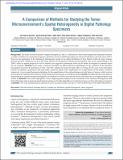Files in this item
A comparison of methods for studying the tumor microenvironment's spatial heterogeneity in digital pathology specimens
Item metadata
| dc.contributor.author | Nearchou, Ines P. | |
| dc.contributor.author | Soutar, Daniel A. | |
| dc.contributor.author | Ueno, Hideki | |
| dc.contributor.author | Harrison, David James | |
| dc.contributor.author | Arandelovic, Oggie | |
| dc.contributor.author | Caie, Peter David | |
| dc.date.accessioned | 2021-02-11T10:30:14Z | |
| dc.date.available | 2021-02-11T10:30:14Z | |
| dc.date.issued | 2021-01-28 | |
| dc.identifier | 271854968 | |
| dc.identifier | 75a097b5-ebc4-40d3-90ae-cd8fb14b112b | |
| dc.identifier | 85102283937 | |
| dc.identifier.citation | Nearchou , I P , Soutar , D A , Ueno , H , Harrison , D J , Arandelovic , O & Caie , P D 2021 , ' A comparison of methods for studying the tumor microenvironment's spatial heterogeneity in digital pathology specimens ' , Journal of Pathology Informatics , vol. 12 , 6 . https://doi.org/10.4103/jpi.jpi_26_20 | en |
| dc.identifier.issn | 2153-3539 | |
| dc.identifier.other | ORCID: /0000-0001-9041-9988/work/88731019 | |
| dc.identifier.other | ORCID: /0000-0002-0031-9850/work/88731219 | |
| dc.identifier.other | ORCID: /0000-0002-1863-5413/work/88731450 | |
| dc.identifier.uri | https://hdl.handle.net/10023/21410 | |
| dc.description | This study was supported by Lothian University Hospitals, Medical Research Scotland and Indica Labs, Inc. Indica Labs, Inc. also provided in-kind resource. | en |
| dc.description.abstract | Background: The tumor microenvironment is highly heterogeneous, and it is understood to affect tumor progression and patient outcome. A number of studies have reported the prognostic significance of tumor-infiltrating lymphocytes and tumor budding in colorectal cancer. However, the significance of the intra-tumoral heterogeneity present in the spatial distribution of these features within the tumor immune microenvironment (TIME) has not been previously reported. Evaluating this intra-tumoral heterogeneity may aid the understanding of the TIME’s effect on patient prognosis as well as identify novel aggressive phenotypes which can be further investigated as potential targets for new treatment. Methods: In this study we propose and apply two spatial statistical methodologies for the evaluation of the intra-tumor heterogeneity present in the distribution of CD3+ and CD8+ lymphocytes and tumor buds in 232 stage II colorectal cancer cases. Getis-Ord hotspot analysis was applied to quantify the cold and hotspots, defined as regions with a significantly low or high number of each feature of interest, respectively. A novel spatial heatmap methodology for the quantification of the cold and hotspots of each feature of interest, which took into account both the inter-patient heterogeneity and the intra-tumor heterogeneity, was further developed. Results: Resultant data from each analysis, characterizing the spatial intra-tumor heterogeneity of lymphocytes and tumor buds, were used for the development of two new highly prognostic risk models. Conclusions: Our results highlight the value of applying spatial statistics for the assessment of the intra-tumor heterogeneity. Both Getis-Ord hotspot and our proposed Spatial Heatmap analysis are broadly applicable across other tissue types as well as other features of interest. | |
| dc.format.extent | 9 | |
| dc.format.extent | 2144370 | |
| dc.language.iso | eng | |
| dc.relation.ispartof | Journal of Pathology Informatics | en |
| dc.subject | Getis-Ord analysis | en |
| dc.subject | Heatmap analysis | en |
| dc.subject | Lymphocytic infiltration | en |
| dc.subject | Spatial heterogeneity | en |
| dc.subject | Tumor prognosis | en |
| dc.subject | RC0254 Neoplasms. Tumors. Oncology (including Cancer) | en |
| dc.subject | RB Pathology | en |
| dc.subject | DAS | en |
| dc.subject | SDG 3 - Good Health and Well-being | en |
| dc.subject.lcc | RC0254 | en |
| dc.subject.lcc | RB | en |
| dc.title | A comparison of methods for studying the tumor microenvironment's spatial heterogeneity in digital pathology specimens | en |
| dc.type | Journal article | en |
| dc.contributor.institution | University of St Andrews. Cellular Medicine Division | en |
| dc.contributor.institution | University of St Andrews. Sir James Mackenzie Institute for Early Diagnosis | en |
| dc.contributor.institution | University of St Andrews. School of Medicine | en |
| dc.contributor.institution | University of St Andrews. School of Computer Science | en |
| dc.contributor.institution | University of St Andrews. Centre for Biophotonics | en |
| dc.identifier.doi | https://doi.org/10.4103/jpi.jpi_26_20 | |
| dc.description.status | Peer reviewed | en |
| dc.date.embargoedUntil | 2021-01-28 |
This item appears in the following Collection(s)
Items in the St Andrews Research Repository are protected by copyright, with all rights reserved, unless otherwise indicated.

